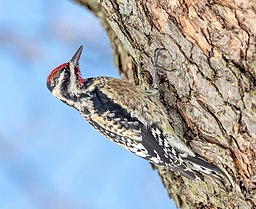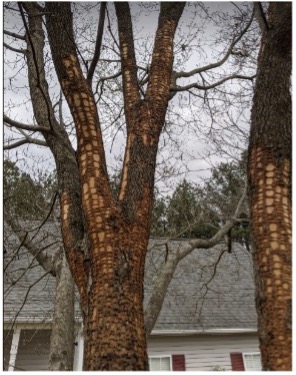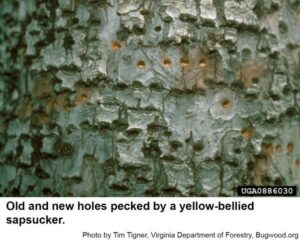Yellow-Bellied Sapsucker Damage
go.ncsu.edu/readext?788129
en Español / em Português
El inglés es el idioma de control de esta página. En la medida en que haya algún conflicto entre la traducción al inglés y la traducción, el inglés prevalece.
Al hacer clic en el enlace de traducción se activa un servicio de traducción gratuito para convertir la página al español. Al igual que con cualquier traducción por Internet, la conversión no es sensible al contexto y puede que no traduzca el texto en su significado original. NC State Extension no garantiza la exactitud del texto traducido. Por favor, tenga en cuenta que algunas aplicaciones y/o servicios pueden no funcionar como se espera cuando se traducen.
Português
Inglês é o idioma de controle desta página. Na medida que haja algum conflito entre o texto original em Inglês e a tradução, o Inglês prevalece.
Ao clicar no link de tradução, um serviço gratuito de tradução será ativado para converter a página para o Português. Como em qualquer tradução pela internet, a conversão não é sensivel ao contexto e pode não ocorrer a tradução para o significado orginal. O serviço de Extensão da Carolina do Norte (NC State Extension) não garante a exatidão do texto traduzido. Por favor, observe que algumas funções ou serviços podem não funcionar como esperado após a tradução.
English
English is the controlling language of this page. To the extent there is any conflict between the English text and the translation, English controls.
Clicking on the translation link activates a free translation service to convert the page to Spanish. As with any Internet translation, the conversion is not context-sensitive and may not translate the text to its original meaning. NC State Extension does not guarantee the accuracy of the translated text. Please note that some applications and/or services may not function as expected when translated.
Collapse ▲Have you noticed strange markings on your elm, apple or dogwood tree? The yellow-bellied sapsucker, Sphyrapicus varius, is leaving a trail. It is the only member of the woodpecker family that pecks a series of horizontal ¼ inch holes in the bark of trees. The holes are uniform in neat little rows. The holes are spaced close together along limbs and trunks of trees. This creates interest for those who are not familiar with the damage. In some cases, severe damage may occur and cause the bark to have a lattice appearance as seen in the picture here. While insects are a large part of the sapsucker’s diet, they also like to sip sap from live trees and have been known to eat the cambium and inner bark.

Photo: Yellow-Bellied Sapsucker
Rhododendrites, CC BY-SA 4.0, via Wikimedia Commons
There are more than 250 species of woody plants that sapsuckers may attack. These include maple, pine, elm, apple, and dogwood to name a few. Sapsuckers are attracted to trees infected with heart rot fungi. This helps in the decaying process of the tree and enables the birds to excavate a nest hole. Sapsuckers can be seen in spring testing trees by pecking sample holes as they select the perfect tree for them. The sapsuckers may visit a tree multiple times a day throughout the season and come back year after year.
Usually trees recover from minor damage. However, excessive holes can allow entry for unwanted pests such as insects and decay fungi. This can lead to secondary damage of the tree causing recovery unlikely. Control sapsuckers can be somewhat of a challenge. They are woodpeckers and are protected by the Federal Migratory Bird Treaty Act. Lethal control requires a permit. Therefore, strategies to help deter sapsuckers are encouraged. Burlap can be wrapped around the tree and may work well. It may also help steer them to a neighbor’s tree. The burlap should not be left on the tree for long periods of time since other damage may occur to the tree. Shiny items such as reflective tape, old CDs. and aluminum pie pans can also be hung from trees to deter the birds. The birds are spooked when the sunlight is reflected from them. Various sounds and hawk or owl decoys can be placed nearby. Decoys need to be moved around every two or three days to look real. Lastly, the tree could be covered with plastic netting.
Yellow-Bellied Sapsucker
This factsheet describes the biology of the yellow-bellied sapsucker, Sphyrapicus varius, a woodpecker that may cause damage to woody plants.






